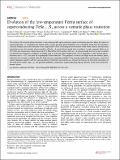Files in this item
Evolution of the low-temperature Fermi surface of superconducting FeSe1−xSx across a nematic phase transition
Item metadata
| dc.contributor.author | Coldea, Amalia I. | |
| dc.contributor.author | Blake, Samuel F. | |
| dc.contributor.author | Kasahara, Shigeru | |
| dc.contributor.author | Haghighirad, Amir A. | |
| dc.contributor.author | Watson, Matthew D. | |
| dc.contributor.author | Knafo, William | |
| dc.contributor.author | Choi, Eun Sang | |
| dc.contributor.author | McCollam, Alix | |
| dc.contributor.author | Reiss, Pascal | |
| dc.contributor.author | Yamashita, Takuya | |
| dc.contributor.author | Bruma, Mara | |
| dc.contributor.author | Speller, Susannah C. | |
| dc.contributor.author | Matsuda, Yuji | |
| dc.contributor.author | Wolf, Thomas | |
| dc.contributor.author | Shibauchi, Takasada | |
| dc.contributor.author | Schofield, Andrew J. | |
| dc.date.accessioned | 2019-02-22T09:30:05Z | |
| dc.date.available | 2019-02-22T09:30:05Z | |
| dc.date.issued | 2019-01-04 | |
| dc.identifier | 257835825 | |
| dc.identifier | 90c80d9d-c067-4779-8a2b-eda41b828fce | |
| dc.identifier | 85059509613 | |
| dc.identifier | 000470236300001 | |
| dc.identifier.citation | Coldea , A I , Blake , S F , Kasahara , S , Haghighirad , A A , Watson , M D , Knafo , W , Choi , E S , McCollam , A , Reiss , P , Yamashita , T , Bruma , M , Speller , S C , Matsuda , Y , Wolf , T , Shibauchi , T & Schofield , A J 2019 , ' Evolution of the low-temperature Fermi surface of superconducting FeSe 1−x S x across a nematic phase transition ' , npj Quantum Materials , vol. 4 , no. 1 , 2 . https://doi.org/10.1038/s41535-018-0141-0 | en |
| dc.identifier.issn | 2397-4648 | |
| dc.identifier.other | RIS: urn:9ED681814BF018BA10524E8D1DC924D5 | |
| dc.identifier.other | RIS: Coldea2019 | |
| dc.identifier.other | ORCID: /0000-0002-0737-2814/work/54516673 | |
| dc.identifier.uri | https://hdl.handle.net/10023/17134 | |
| dc.description | This work was mainly supported by EPSRC (EP/L001772/1, EP/I004475/1, EP/I017836/1). A.A.H. acknowledges the financial support of the Oxford Quantum Materials Platform Grant (EP/M020517/1). A portion of this work was performed at the National High Magnetic Field Laboratory, which is supported by National Science Foundation Cooperative Agreement No. DMR-1157490 and the State of Florida. This research was supported in part by the National Science Foundation under Grant No. NSF PHY17-48958. Part of this work was supported by HFML-RU/FOM and LNCMI-CNRS, members of the European Magnetic Field Laboratory (EMFL) and by EPSRC (UK) via its membership to the EMFL (grant no. EP/N01085X/1). Part of this work was supported by Programme Investissements d’ Avenir under the programme ANR-11-IDEX-0002-02, reference ANR-10-LABX-0037-NEXT. The authors would like to acknowledge the use of the University of Oxford Advanced Research Computing (ARC) facility in carrying out part of this work. A.I.C. thanks the hospitality of KITP supported by the National Science Foundation under Grant No. NSF PHY- 1125915. A.I.C. acknowledges an EPSRC Career Acceleration Fellowship (EP/I004475/1). | en |
| dc.description.abstract | The existence of a nematic phase transition in iron-chalcogenide superconductors poses an intriguing question about its impact on superconductivity. To understand the nature of this unique quantum phase transition, it is essential to study how the electronic structure changes across this transition at low temperatures. Here, we investigate the evolution of the Fermi surfaces and electronic interactions across the nematic phase transition of FeSe1−xSx using Shubnikov-de Haas oscillations in high magnetic fields up to 45 T in the low temperature regime down to 0.4 K. Most of the Fermi surfaces of FeSe1−xSx monotonically increase in size except for a prominent low frequency oscillation associated with a small, but highly mobile band, which disappears at the nematic phase boundary near x ~ 0.17, indicative of a topological Lifshitz transition. The quasiparticle masses are larger inside the nematic phase, indicative of a strongly correlated state, but they become suppressed outside it. The experimentally observed changes in the Fermi surface topology, together with the varying degree of electronic correlations, will change the balance of electronic interactions in the multi-band system FeSe1−xSx and promote different kz-dependent superconducting pairing channels inside and outside the nematic phase. | |
| dc.format.extent | 7 | |
| dc.format.extent | 3169818 | |
| dc.language.iso | eng | |
| dc.relation.ispartof | npj Quantum Materials | en |
| dc.subject | QC Physics | en |
| dc.subject | DAS | en |
| dc.subject.lcc | QC | en |
| dc.title | Evolution of the low-temperature Fermi surface of superconducting FeSe1−xSx across a nematic phase transition | en |
| dc.type | Journal article | en |
| dc.contributor.institution | University of St Andrews. Centre for Designer Quantum Materials | en |
| dc.contributor.institution | University of St Andrews. School of Physics and Astronomy | en |
| dc.identifier.doi | 10.1038/s41535-018-0141-0 | |
| dc.description.status | Peer reviewed | en |
This item appears in the following Collection(s)
Items in the St Andrews Research Repository are protected by copyright, with all rights reserved, unless otherwise indicated.

